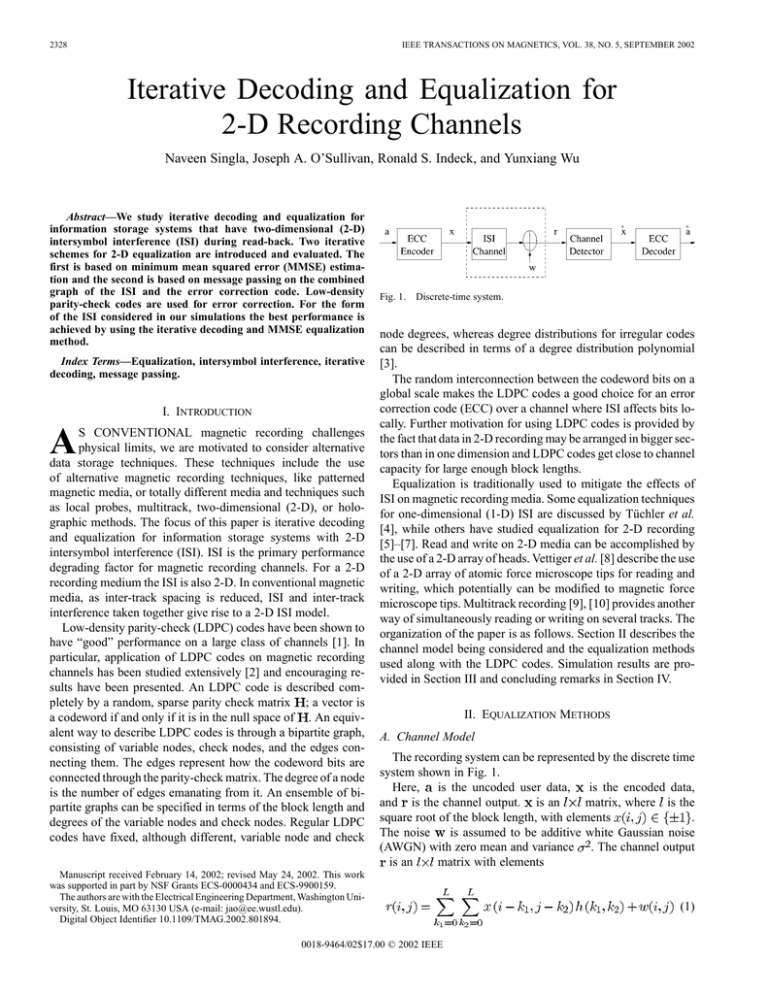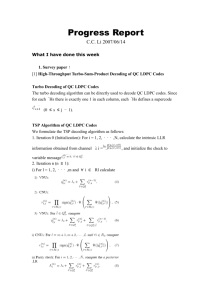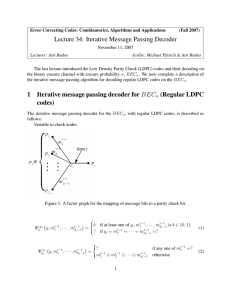Iterative decoding and equalization for 2-d recording
advertisement

2328 IEEE TRANSACTIONS ON MAGNETICS, VOL. 38, NO. 5, SEPTEMBER 2002 Iterative Decoding and Equalization for 2-D Recording Channels Naveen Singla, Joseph A. O’Sullivan, Ronald S. Indeck, and Yunxiang Wu Abstract—We study iterative decoding and equalization for information storage systems that have two-dimensional (2-D) intersymbol interference (ISI) during read-back. Two iterative schemes for 2-D equalization are introduced and evaluated. The first is based on minimum mean squared error (MMSE) estimation and the second is based on message passing on the combined graph of the ISI and the error correction code. Low-density parity-check codes are used for error correction. For the form of the ISI considered in our simulations the best performance is achieved by using the iterative decoding and MMSE equalization method. Index Terms—Equalization, intersymbol interference, iterative decoding, message passing. I. INTRODUCTION A S CONVENTIONAL magnetic recording challenges physical limits, we are motivated to consider alternative data storage techniques. These techniques include the use of alternative magnetic recording techniques, like patterned magnetic media, or totally different media and techniques such as local probes, multitrack, two-dimensional (2-D), or holographic methods. The focus of this paper is iterative decoding and equalization for information storage systems with 2-D intersymbol interference (ISI). ISI is the primary performance degrading factor for magnetic recording channels. For a 2-D recording medium the ISI is also 2-D. In conventional magnetic media, as inter-track spacing is reduced, ISI and inter-track interference taken together give rise to a 2-D ISI model. Low-density parity-check (LDPC) codes have been shown to have “good” performance on a large class of channels [1]. In particular, application of LDPC codes on magnetic recording channels has been studied extensively [2] and encouraging results have been presented. An LDPC code is described completely by a random, sparse parity check matrix ; a vector is a codeword if and only if it is in the null space of . An equivalent way to describe LDPC codes is through a bipartite graph, consisting of variable nodes, check nodes, and the edges connecting them. The edges represent how the codeword bits are connected through the parity-check matrix. The degree of a node is the number of edges emanating from it. An ensemble of bipartite graphs can be specified in terms of the block length and degrees of the variable nodes and check nodes. Regular LDPC codes have fixed, although different, variable node and check Fig. 1. Discrete-time system. node degrees, whereas degree distributions for irregular codes can be described in terms of a degree distribution polynomial [3]. The random interconnection between the codeword bits on a global scale makes the LDPC codes a good choice for an error correction code (ECC) over a channel where ISI affects bits locally. Further motivation for using LDPC codes is provided by the fact that data in 2-D recording may be arranged in bigger sectors than in one dimension and LDPC codes get close to channel capacity for large enough block lengths. Equalization is traditionally used to mitigate the effects of ISI on magnetic recording media. Some equalization techniques for one-dimensional (1-D) ISI are discussed by Tüchler et al. [4], while others have studied equalization for 2-D recording [5]–[7]. Read and write on 2-D media can be accomplished by the use of a 2-D array of heads. Vettiger et al. [8] describe the use of a 2-D array of atomic force microscope tips for reading and writing, which potentially can be modified to magnetic force microscope tips. Multitrack recording [9], [10] provides another way of simultaneously reading or writing on several tracks. The organization of the paper is as follows. Section II describes the channel model being considered and the equalization methods used along with the LDPC codes. Simulation results are provided in Section III and concluding remarks in Section IV. II. EQUALIZATION METHODS A. Channel Model The recording system can be represented by the discrete time system shown in Fig. 1. Here, is the uncoded user data, is the encoded data, matrix, where is the and is the channel output. is an . square root of the block length, with elements is assumed to be additive white Gaussian noise The noise (AWGN) with zero mean and variance . The channel output is an matrix with elements Manuscript received February 14, 2002; revised May 24, 2002. This work was supported in part by NSF Grants ECS-0000434 and ECS-9900159. The authors are with the Electrical Engineering Department, Washington University, St. Louis, MO 63130 USA (e-mail: jao@ee.wustl.edu). Digital Object Identifier 10.1109/TMAG.2002.801894. 0018-9464/02$17.00 © 2002 IEEE (1) SINGLA et al.: ITERATIVE DECODING AND EQUALIZATION FOR 2-D RECORDING CHANNELS 2329 Fig. 2. The full graph includes edges connecting variable nodes (x ) to the check nodes (not shown) and to the data nodes (r ). The 2-D ISI yields many length four cycles in this graph for example r x r x r . ! ! ! ! where represents the number of elements over which the ISI extends in each dimension and is the 2-D channel point spread function. For our simulations, we use Fig. 3. Performance curves for the proposed schemes. For error correction, we use LDPC coset codes [11] with the code graph chosen uniformly at random from the ensemble of regular graphs. B. Equalization Methods Two equalization methods are studied, the first based on minimum mean-squared error (MMSE) estimation, and the second based on message passing on the ISI and LDPC code graph. For the first scheme, equalization was performed using a Wiener filter which is designed subject to the input power constraint and assuming the input to be Gaussian. 2-D MMSE equalization has been shown to be very effective for detection on 2-D ISI channels [7]. The Wiener filter is applied iteratively if decoding failed after a single application with either soft or hard information being passed from the LDPC decoder to the Wiener filter. The soft information passed is the estimated mean of the codeword and the hard information is the estimated codeword. At each iteration, the Wiener filter operation is the codeword bits. The message-passing algorithm is described in [1], [12]. The decoding complexity of the message-passing algorithm, per iteration, is linear in the block length. The APP of the code bits is initialized using the observed data. After initialization the APP algorithm first passes messages on the LDPC bipartite graph for a fixed number of iterations and if decoding fails then message passing is done on the threelevel graph again for a fixed number of iterations. The message, passing schedule used on this “full graph” is where are the variable nodes, are the parity check nodes, and are the observed data nodes. While performing message passing for the variable to check and variable to data messages, we also have to consider the messages sent to the variable nodes from the data nodes and check nodes, respectively. III. RESULTS A. Signal-to-Noise Ratio (SNR) Definition For a channel with ISI, the SNR is defined as (2) is the information where is the current iteration number, passed to the Wiener filter by the LDPC decoder at the th iteris the Wiener filter, is the MMSE estimate which ation, is used by the LDPC decoder for initializing the posteriors, and represents 2-D convolution. The second equalization method studied is a pure a posteriori probability (APP)-based algorithm that is used for both equalization and decoding. This algorithm computes approximate APPs of the codeword bits given the observations by performing message passing on a three-level graph of the LDPC code and the channel ISI. The APPs would be exact if there were no loops in the graph topology, but as we see in Fig. 2, this is not the case for a 2-D ISI channel. The upper two levels in the graph represent the LDPC code bipartite graph. The lower two levels represent the channel ISI graph showing how the ISI connects the codeword bits to the observed data. Messages passed on the graph are probabilities calculated using the observed data to approximate the APPs of dB (3) is the energy per bit at the user side, is the where norm of the channel ISI, is the code rate (the ratio of the is the number of user bits to the number of code bits), and noise variance. B. Simulation Results The results for the proposed iterative decoding schemes are shown in Fig. 3. The ECC used was a block length 10000, rate 1/2 regular (3,6) LDPC code. The input data is obtained by scanning the codeword bits into a 100 100 matrix. Prior to transmission, a guard band of all 1’s is added around the codeword matrix, the purpose of which can be to isolate sectors in 2-D and also to provide termination for our algorithms. The Wiener filter as implemented here has infinite support. Capacity computation for a discrete input 2-D ISI channel is still an open problem. In Fig. 3, we compare the performance of 2330 IEEE TRANSACTIONS ON MAGNETICS, VOL. 38, NO. 5, SEPTEMBER 2002 better performance on a 2-D ISI channel also. For the block lengths being considered here, however, the improvement is not significant. The reason for this is that irregular LDPC codes are optimized assuming a large block length, so significant gain in performance over regular codes is observed only when the block length is large [3]. IV. CONCLUSION Fig. 4. Performance comparison of different MMSE-LDPC schedules. our decoding schemes to the performance of the LDPC code on the AWGN channel without ISI. The figure also shows the capacity of a binary input AWGN channel with no ISI. The Wiener filter applied iteratively for ten iterations using soft information from the LDPC decoder has the best performance among the three schemes at about 2 dB from the LDPC code performance at a bit-error rate of 10 . The full-graph algorithm iterates for 50 iterations on the LDPC bipartite graph, and if decoding fails, then it iterates for ten iterations on the three-level graph. The performance of the full graph algorithm is degraded due to the presence of length four cycles in the channel ISI graph. As noted in the literature [12], the presence of many short cycles, as in this case, deteriorates the performance of the message passing algorithm. The curve labeled “Wiener” in Fig. 3 is the performance when MMSE equalization is done only once. No undetected errors were observed in the simulations. The plots in Fig. 4 show how the MMSE equalizer performance varies with different message passing schedules between the equalizer and LDPC decoder. At the first iteration, an MMSE equalization is done on the observed data and the filtered data is passed on to the LDPC decoder. The LDPC decoder iterates for a fixed number of iterations for each iteration of the equalizer and then passes information, soft or hard, to the equalizer. This is continued until the decoder converges to a codeword or a preset number of maximum iterations of the equalizer are exhausted, ten for our simulations. Irregular LDPC codes, when optimized, perform better than regular LDPC codes, as shown in [3], so we expect Iterative decoding and equalization schemes for information storage systems with 2-D ISI were introduced and evaluated. The Wiener filter applied iteratively with soft information passed to the LDPC code decoder gives the best performance. An algorithm that does message passing on the three-level graph of the LDPC code and channel ISI is introduced. Its performance is degraded due to the presence of short cycles in the channel ISI graph. Other message-passing schedules are being considered to pass messages on the full graph in order to avoid short cycles, which would enhance the performance significantly. REFERENCES [1] D. J. C. Mackay, “Good error-correcting codes based on very sparse matrices,” IEEE Trans. Inform. Theory, vol. 45, pp. 399–431, Mar. 1999. [2] H. Song, R. M. Todd, and J. R. Cruz, “Performance of low-density parity-check codes on magnetic recording Channels,” in Proc. 2nd Int. Symp. Turbo Codes and Related Topics, Sept. 2000, pp. 395–398. [3] T. Richardson, A. Shokrollahi, and R. Urbanke, “Design of capacity-approaching irregular low-density parity-check codes,” IEEE Trans. Inform. Theory, vol. 47, pp. 619–637, Feb. 2001. [4] M. Tüchler, R. Koetter, and A. Singer, “Turbo equalization: Principles and new results,” IEEE Trans. Commun., vol. 50, pp. 754–767, May 2002. [5] W. Weeks IV, “Full Surface Data Storage,” Ph.D. dissertation, Univ. Illinois at Urbana Champaign, 2000. [6] R. Krishnamoorthi, “Two-Dimensional Viterbi Like Algorithms,” M.S. thesis, Univ. Illinois at Urbana Champaign, 1998. [7] X. Chen, K. M. Chugg, and M. A. Neifeld, “Near-optimal parallel distributed data detection for page-oriented optical memories,” IEEE J. Select. Topics Quantum Electron., vol. 4, pp. 866–879, Sept./Oct. 1998. [8] P. Vettiger et al., “The Millipede-more than one thousand tips for future AFM data storage,” IBM J. Res. Develop., vol. 44, no. 3, pp. 323–340, May 2000. [9] E. Soljanin and C. N. Georghiades, “Multihead detection for multi-track recording channels,” IEEE Trans. Inform. Theory, vol. 44, pp. 2988–2997, Nov. 1998. [10] P. J. Davey, T. Donnelly, D. J. Mapps, and N. Darragh, “Two-dimensional coding for a multi-track recording system to combat inter-track interference,” IEEE Trans. Magn., vol. 34, pp. 1949–1951, July 1998. [11] A. Kavčić, X. Ma, and M. Mitzenmacher, “Binary intersymbol interference channels: Gallager codes, density evolution and code performance bounds,” IEEE Trans. Inform. Theory, submitted for publication. [12] F. R. Kschischang, B. J. Frey, and H. A. Loeliger, “Factor graphs and the sum-product algorithm,” IEEE Trans. Inform. Theory, vol. 47, pp. 498–519, Feb. 2001.


